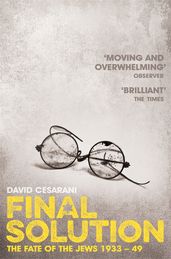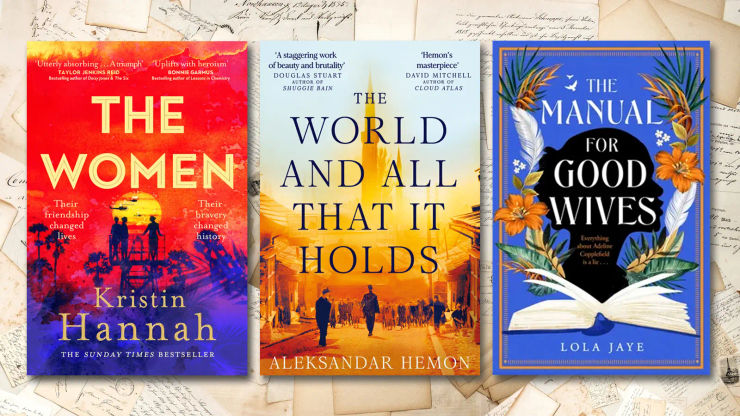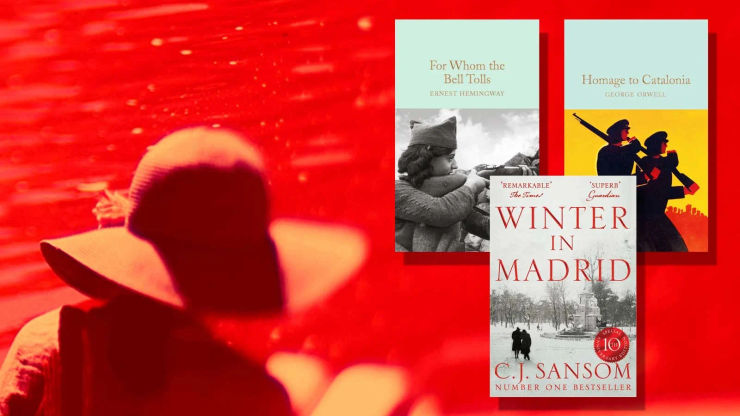David Cesarani on how we remember The Holocaust
An extract from the late David Cesarani's intelligent, comprehensive and authoritative history of the Holocaust, Final Solution, to mark Holocaust Memorial Day.

Holocaust Memorial Day, which takes place on 27 January, commemorates the millions of people who have been murdered or whose lives have been changed beyond recognition during the Holocaust, Nazi Persecution and in subsequent genocides in Cambodia, Rwanda, Bosnia and Darfur.
Read on for an extract from David Cesarani's book, Final Solution: The Fate of the Jews 1933-49, on how the Holocaust is remembered and commemorated in the modern era, and discover our list of more essential books about The Holocaust to help us learn and remember here.
The Holocaust has never been so ubiquitous. It has never been studied so extensively, taught so widely, or taken with such frequency as a subject for novels and films. On 1 November 2005, the General Assembly of the United Nations adopted 27th January as International Holocaust Remembrance Day so that it is now commemorated almost universally, held up as the global benchmark for evil, as the ultimate violation of human rights and crimes against humanity. The seventieth anniversary of the liberation of Auschwitz and the concentration camps was marked with ceremonies attended by heads of state and church leaders alongside the frail, shrinking band of survivors.
However, there is a yawning gulf between popular understanding of this history and current scholarship on the subject. This is hardly surprising given that most people acquire their knowledge of the Nazi past and the fate of the Jews through novels, films, or earnest but ill-informed lessons at school, which frequently rely on novels for young adults or their filmic versions. Misconceptions are reinforced by the edited and instrumentalized versions purveyed by campaigning bodies and the constellation of organizations devoted to education and commemoration.
Although these efforts are made in good faith, they are subordinate to extraneous agendas, be it the desire to cultivate an inclusive national identity or the laudable determination to combat anti-Semitism, racism, homophobia and other forms of political, religious or ethnic intolerance. Some lazily draw on an outdated body of research, while others utilize state-of-the-art research but downplay inconvenient aspects of the newer findings.
It is easier to arrange one-day visits to Auschwitz-Birkenau, where an estimated 960,000 Jews were murdered, than to Treblinka, where some 860,000 Jews were killed in a shorter space of time, let alone to the broadly dispersed but omnipresent killing fields of Belarus and Ukraine, where around one and half million Jews were shot to death.
Conscientious educators preparing and accompanying the flying visits to Auschwitz and Birkenau strive to frame the concentration and extermination camp within the larger history of the genocide inflicted on the Jews, but the emotional charge that imprints the historical data on the mind is inevitably shaped by physically witnessing this one site. Notwithstanding the intense preparation, the other locations where most Jews suffered, died, and were done to death remain distant.
As a result, the customary narrative is lopsided. The emphasis on deportations to death camps, particularly from western Europe and particularly to Auschwitz, overshadows the benighted experience of Jews in Polish ghettos. Yet the number of Jews incarcerated in the ghettos of Warsaw and Lodz in 1940–1 exceeds the combined Jewish populations in France, Belgium, and the Netherlands at the same time. More Jews died in Warsaw than were deported from France to the killing sites of eastern Europe. More Jews were shot within walking distance of their homes in Kiev on 29–30 September 1941 than were forced to endure the horrendous five-day journey in box-cars from transit camps in Belgium to death camps in Poland. Yet one of the most typical Holocaust memorials is a freight car mounted on a segment of rail track.
The use of survivor testimony routinely trumps the dissemination of scholarship. Survivors may only be able to illuminate a tiny corner of the sprawling historical tragedy from their own experience, but they were there, so their every word is highly charged. However, the use of survivor testimony in educational and commemorative settings swerves comprehension in the direction of a small cadre whose experiences are unrepresentative.
It is trite to remark that as survivors they are atypical of what the majority of Jews endured under Nazi rule. More pertinently, the passage of time dictates that they could only have experienced the Nazi years as children, teenagers or young adults. They observed the dilemmas of adults and can report on how things were for their mothers, fathers, grandparents and older relatives, but they cannot testify to what it felt like to be a middle-aged person confronted by persecution and unnatural death. They can only offer an echo of what it meant to lose homes and businesses, the painfully acquired achievements of a lifetime or several generations.
Young people were largely insulated from, or took no direct part in, the internecine struggles that typified life in Jewish communities under ruthless pressure to divide one from another: those fit to work from those unfit, those with resources from those with none, those with contacts amongst the authorities from those bereft of patronage. They witnessed but did not feel the emotions of adults trying to protect children and loved ones, the despair and rage that accompanied helplessness and, ultimately, loss.
On the contrary, what survivors offer is a wonderful example of how youthful traumas can be overcome. They show how it is possible to rebuild in one generation what was mercilessly destroyed in the previous one. Inspiring testimony such as this inevitably carries a redemptive message. No matter how unpleasant or unvarnished the content, the age of the speaker, and the courage they show in recalling horrendous times bestows on them a heroic aura. They are envoys from a fearful distant past, bearing a message of hope – that survival and recuperation is possible whatever the odds against them.
Commemorative events, especially those with survivors present, are naturally constructed to avoid sensitive and conflicted subjects. They steer around phenomena like the corruption of life in the ghettos and the moral degradation of camp inmates. They skirt awkward questions of forced cooperation with the German authorities or acts of pre-meditated revenge. They maintain a discreet silence over instances of voluntary infanticide, sexual exploitation amongst the Jews, rape and even cannibalism. Yet all these things occurred at times in ghettos, camps, urban hideouts and forest sanctuaries.
Educational programmes have more latitude and ambition when confronting such touchy issues, but since they are designed to inoculate against racism, the emphasis is on the crimes of the Germans, their allies and accomplices or the indifference of ‘bystanders’. To dwell on the terrible things that Jews did to Jews would be tantamount to ‘blaming the victims’, a variety of prejudicial thinking that ‘Holocaust education’ is itself supposed to expunge. Ironically, these are the very areas currently being explored by responsible, conscientious researchers.
The nomenclature is itself increasingly self-defeating. The Holocaust, capitalized here to signify the cultural construction rather than the historical events to which it is assumed to refer, has come to imply a unitary event characterized by systematic procedures and a uniformity of experience. But newer histories point to the nuances between different countries, regions, districts, and even adjacent villages. They are more sensitized to variations over time, breaking it down into locales and segments, each with distinctive characteristics that could accentuate the chances of life or death.
Certain historians argue that a number of overlapping genocides raged within The Holocaust. Romania, for example, embarked on murderous ethnic cleansing against local Jews to suit a national agenda that was distinctive from, and even cut across, German aspirations. Perspectives on the catastrophe are changing, yet this is barely reflected in the reproduction of an agreed but ageing narrative.
This book grew out of a concern about the discord between, on the one side, evocations of The Holocaust in popular culture, education and its commemoration and, on the other, the revelations by researchers in many disciplines, operating within and outside an academic framework. The divergence has become acute since the 1990s, thanks to the vastly increased volume of research that followed the end of the Cold War and the opening of archives in Eastern Europe.
Access to these new archives facilitated individual scholarship and enabled teams to investigate Jewish slave labour and the fate of Jewish property and assets. Over a dozen countries organized historical commissions to deal with accusations about their wartime record. Their example was followed by financial institutions and industrial corporations. The result was a flood of weighty reports, scholarly articles, and monographs, not to mention accounts by journalists, politicians and activists.
Around the turn of the century, historians including Michael Burleigh, Ian Kershaw, Peter Longerich, Christopher Browning, Richard Evans and Saul Friedländer wove this new material into fresh narratives of Hitler’s life, the Third Reich, and the destruction of the Jews. They were outstanding works of synthesis and original insight. While several enjoyed healthy sales worldwide, others had little impact beyond the circle of aficionados.
A number of TV documentaries distilled the new work, although the richness of the original research and some of its shocking implications remained locked away in detailed monographs. There were also several shorter histories that necessarily required analysis, generalization and the recital of bare facts, with the effect that something quintessentially bloody became metaphorically bloodless.
Moreover, in his two-volume history of the persecution and extermination of the Jews, Saul Friedländer raised the bar for all historians tackling the subject. Friedländer set out to construct an ‘integrated history’ that encompassed the perspectives, actions and reactions of the Jews, those who tormented them, and those who observed the unfolding horrors either close-up or from a distance. By drawing on a multitude of contemporary sources he attempted to recover the contingency of events and the chaotic experience of Jews caught up in them, not knowing why things were happening or how they would end.
This account too strives for an ‘integrated history’, but the focus is primarily and unapologetically on the Jews. It also sets out to challenge the traditional concepts and periodization that have until now framed constructions of The Holocaust.
The reappraisal begins with the term itself, a term that arguably is well past its sell-by date. This is not due to the politicization of the word and arguments over what it means, although these are certainly good enough reasons to retire it. To some historians the appellation connotes the Nazi persecution and mass murder of Jews and other victims of the lethal racial-biological policies implemented by the National Socialist regime.
It is commonly taken to also embrace the deliberate mass death of over three million Red Army personnel taken prisoner of war in the wake of the German invasion of the USSR in 1941. Other historians point to the plans adumbrated by certain Nazi officials for the destruction or deliberate starvation of Polish and Russian populations to suggest that they were in part, and potentially in whole, victims of The Holocaust.
Many Jewish historians insist that the term be limited to the Jewish victims of specifically anti-Semitic measures. In Israel the word Shoah is preferred because, as a Hebrew word, it automatically tends to refer to Jews only. In this respect it echoes the Yiddish terminology favoured by many survivor-historians immediately after 1945, such as ‘churban’, although they also made free use of the Yiddish equivalent of words such as catastrophe and destruction. However, Yiddish authors wrote unselfconsciously while those who use Shoah do so deliberately to denote a Jewish event. Since the word is both Judeocentric and embodied in the official Israeli memorial day Yom ha-Shoah, such usage is frequently taken to indicate a supposedly ‘Zionist’ version, in which Jew-hatred is ineradicable, genocide was inevitable, and the only security for Jews lies in statehood.
This ideological dispute over meaning is not, however, the real problem. Rather, the ubiquity of a standardized version under the rubric of The Holocaust in popular culture and education has created a received wisdom about what it was. The expectations conjured up by the word are then often confirmed and reinforced by the rituals of commemoration.
In this standardized version, to which I have myself contributed, The Holocaust was the outcome of racist and anti-Semitic policies that were implemented in Germany by the Nazis and then imposed on countries they conquered or adopted by the allies they made.
It unfolded in stages. First the Jews of Germany were subjected to discrimination and exclusion from 1933 to 1938. Persecution intended to encourage emigration intensified into forced migration from Germany and Austria in 1938–9. With the coming of war the German authorities began expelling Jews from the Greater Reich and areas they conquered. Throughout 1939–40 Jews in German-occupied Poland were concentrated in ghettos, forced to live under appalling conditions. The physical annihilation of Jewish communities began with the invasion of Russia in 1941, followed by the deportation of Jews from all over Europe to death camps in Poland from 1941 to 1944. It ended with death marches during the last months of Hitler’s Reich. Along the way, the Jews were demonized and dehumanized in propaganda and forced to resemble the reviled image of ‘the Jew’ in centuries-old stereotypes as well as more modern prejudicial representations.
It has become an article of faith that The Holocaust involved the systematic use of state power, modern bureaucratic methods, scientific thinking, and killing methods adapted from industrial production systems. For example, the website of the Holocaust Memorial Day Trust (of which I was a trustee for several years), responsible for over-seeing the annual commemorative and educational activities in Britain around the 27 January anniversary of the liberation of Auschwitz, states that ‘Between 1941 and 1945, the Nazis attempted to annihilate all of Europe’s Jews. This systematic and planned attempt to murder European Jewry is known as the Holocaust.’
The interlocking set of assumptions inherent in the nomenclature is so potent that it is almost impossible to begin a historical work, a novel or a film bearing the label ‘Holocaust’ without anticipating how it will pan out, a phenomenon that Michael André Bernstein labelled ‘backshadowing’.
This reassessment challenges these widely accepted preconceptions.
You can find out more about Holocaust Memorial Day at www.hmd.org.uk.
The Final Solution
by David Cesarani
'A brilliant synthesis and interpretation of the greatest crime of the modern era . . . There is so much of value in this harrowing and extraordinary book that it's hard to encompass in a review . . . There are stories here I didn't know and could scarcely have imagined . . . A book that demands to be read and deserves every historical award going.' Oliver Kamm, The Times



